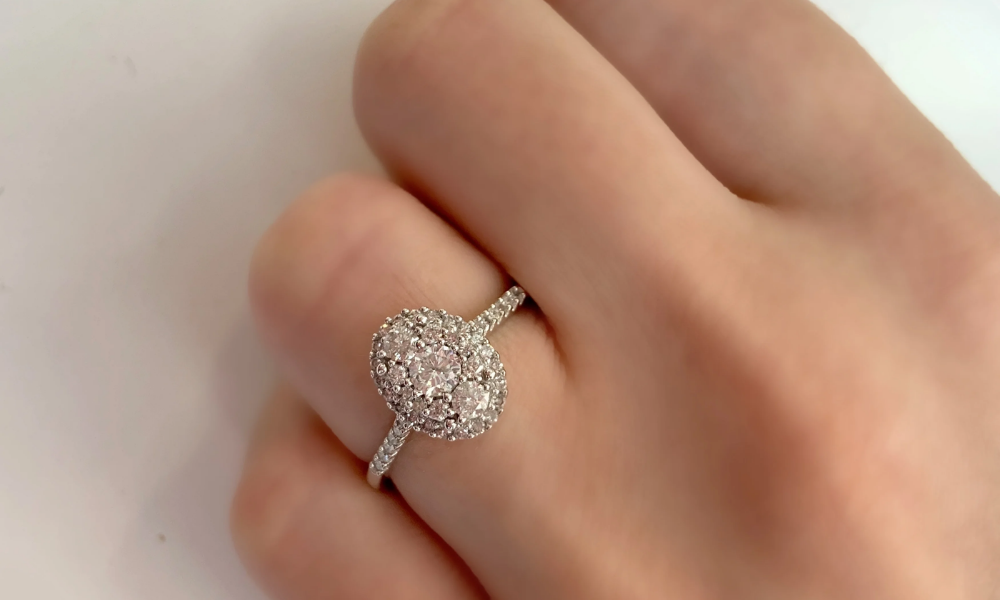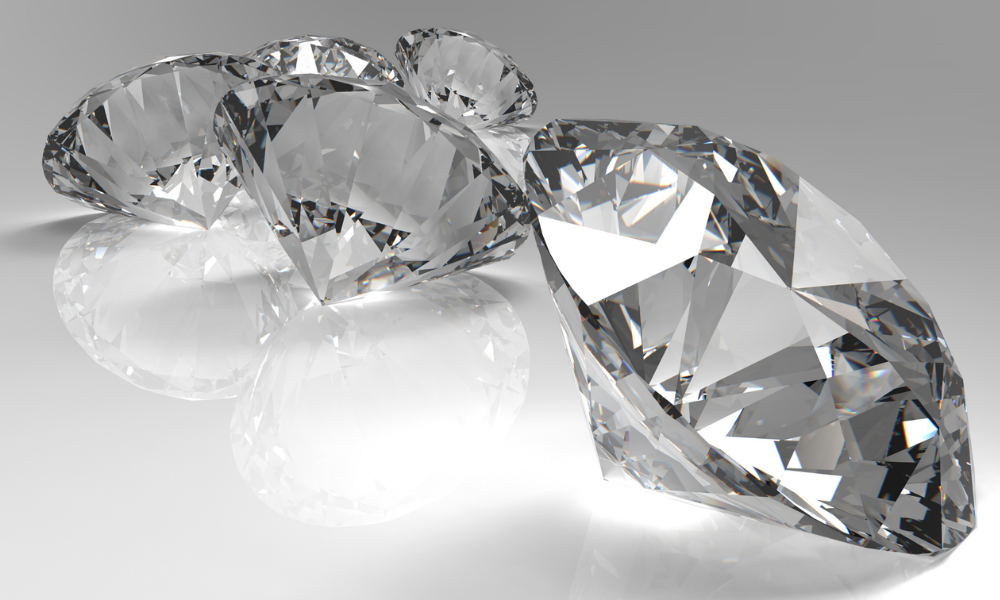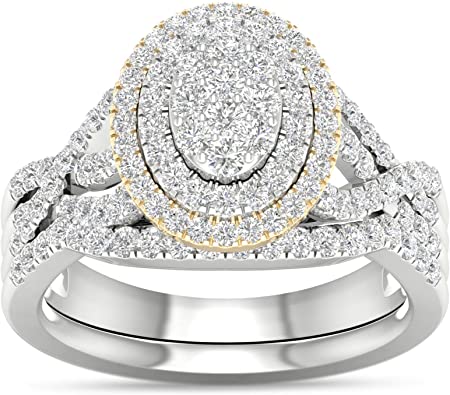Diamonds are considered a girl’s best friend. Therefore it should come as no surprise that most women own some diamond jewelry. However, what exactly is a composite diamond? A composite diamond is made by merging two or more different components to get the desired appearance and hardness. It is possible to find a suitable solution that is affordable and matches your requirements in a composite diamond engagement ring. You may wonder what a composite diamond is because it appears to be radiant and glamorous, but you may not be familiar with it. Let’s find out jointly what it is.
Interested in a massive diamond ring but not concerned about the high price tag? A diamond ring made of composite diamonds might be the solution. These show-stopping engagement rings are typically less expensive, with the same glitter and splendor like a huge diamond. While there are numerous advantages to wearing a composite diamond ring, the price is not as enticing as a single massive gem. Even though these rings do not hold their value over time, they might be a more economical alternative to diamond rings.
What is a Composite Diamond?
Composite diamonds are made up of tiny diamonds that have been skillfully arranged to give the appearance of a larger-looking stone. Alternatively, they can be set in a way that makes them appear as a single stone, or they can be arranged to maximize their beauty or brilliance, for example.
Diamond composite rings depart from the classic diamond solitaire ring, with a single core stone in its center. Interestingly, you can also buy inexpensive composite diamond jewelry that is made out of a few mixed stones that are meant to seem like valuable diamonds, such as these:
- Moissanite
- Strontium titanates
- Cubic zirconia is a type of gemstone.
Advantages and Disadvantages of Composite Diamond Rings
Aside from the fact that they are inexpensive, the design options with composite diamonds are virtually limitless. They are ideal for adding delicate details to your designs. “The clustered designs are always one-of-a-kind and allow greater artistic freedom,” says the designer.
Despite this, there are certain disadvantages. First and foremost, the very significant repair expenses associated with a broken composite diamond can cancel out the savings realized on the item. The future value of a composite diamond ring is not as predictable as the value of a standard-size diamond ring.
Advantages of Composite Diamond Rings
- Composite diamonds have a longer life span than mined diamonds. Since they are made up of two or more pieces, they may be repaired and reassembled multiple times, allowing them to remain in excellent shape for years without a touch-up from a diamond cutter.
- It is easier to sell because the legitimacy of the items cannot be called into question. This is more than simply a surface treatment; this is a genuine diamond, not a fake stone that could be produced out of just about any old piece of material.
- Because they are made in a laboratory, they are less expensive than natural products. Although the procedure is labor-intensive, it is less expensive to manufacture them than mine for the raw ingredients.
- Composite diamonds are more environmentally friendly than traditional diamonds because they are made in a laboratory and do not require any mining or drilling, which can hurt wildlife habitats such as rainforests.
- You will receive the same warranties as if you were to purchase them from a merchant because they are 100 percent natural diamonds.
- A composite diamond possesses many characteristics that distinguish other forms of diamonds, such as the ability to resist scratching and breaking.
Disadvantages of Composite Diamond Rings
- They are not nearly as difficult.
- The hue of the diamonds may be off due to the lack of nitrogen trapped within them, which is often responsible for the diamonds’ white or yellow tinge. When a diamond is worn in jewelry, brownish tints can appear on the surface of the diamond if the substance is present.
- In the case of composite diamonds, there is no grading system in place.
- They must be re-polished every few years since the white color is not as resistant to wear and tear as a natural diamond with nitrogen.
10K Two-Tone Gold 3/4CT TDW Composite Diamond Oval Frame Bridal Set with IGI Certification (I-J, I2)
Features
- Direct from Manufacturer, 100% natural diamonds, Diamond Color/Clarity: I-J, I2, FREE shipping for 3 to 5 Days delivery option with 30 Days Money Back Guarantee
- 10K Two-Tone Rose Gold 3/4CT TDW Composite Diamond Oval Frame Bridal Set with IGI Certification (I-J, I2).Beautiful Gift Box with this special product for you.
- Wide range of collections for Double Halo Bridal Set, Women’s Diamond Engagement Ring Jewelry, Cross over Bridal Set, Bridal ring with a split shank, Round Shape Double Halo Bridal Set, Cushion Shape Bridal Set, Double Halo Square shape Bridal Set, Composite Head Bridal Ring
- All of our items come in the appropriate packaging ensuring they are ready for gifting upon arrival. Wrapped in a classic jewelry box, it includes Cleaning cloth, Thank you card, Jewelry cleaning guidelines and is a thoughtful present for a wife, girlfriend, best friend, fiancée, sister, mom, or someone special at a Wedding, Engagement, Christmas, Birthday, Anniversary, Mothers Day, Valentine’s day, Thanksgiving day and many other special occasions.
- We are confident about the quality of our products and we are sure you will be totally satisfied with our luxurious Jewelry, but if for some reason you are not satisfied with your purchase, our products are always backed by 100% Money-Back with 30 days of purchase, No Question Asked Guaranteed.
Is it Worthwhile to Invest in Composite Diamonds?
They are typically far more economical than a complete, large diamond since it costs less to construct designs out of several tiny diamonds than to create a single large diamond. However, keep in mind that composite diamond rings are subject to wear and tear and may require maintenance and repairs over time.
The components of a composite diamond can be actual diamonds or diamond simulants such as moissanite, cubic zirconia, or diamonds manufactured in a laboratory. It is not how the diamonds are put on top of the shank that determines whether or not they are genuine.
Is the Value of Composite Diamonds Stable?
Since the value of a composite diamond will change with the market, it is critical to understand what you hope to achieve from your purchase.
Cost is more important than care for the stone (for example, if the stone will be passed down or sold). Thus this may be the best option for you.
What are the Differences Between Composite Diamonds and Other Diamond Types?
Although composite diamonds are a relatively new technique, it is impossible to make a direct comparison between the two. But what we know about them is that they are stronger and more durable than other diamonds.
They also provide greater transparency in their colorless condition since there is no nitrogen trapped inside. Because they can be manufactured with less carbon, they are less expensive to produce in terms of manufacturing costs such as cutting and polishing, making them more inexpensive to customers!
What to Look for in a Diamond Composite?
If you are thinking about getting an engagement ring with a composite diamond, here are a few questions and answers to keep in mind when you are shopping.
Is it true that composite diamonds are less expensive than regular diamonds?
They are typically far more economical than a complete, large diamond since it costs less to construct designs out of several tiny diamonds than to create a single large diamond. However, keep in mind that composite diamond rings are subject to wear and tear and may require maintenance and repairs over time.
Do composite diamonds retain their value over time?
The unregulated and emotional nature of the jewelry market makes it difficult to predict the value of traditional diamonds, let alone the value of composite diamonds,” says the author. “Sacheti expresses himself. “Compared to typical diamonds, they have far inferior value retention. However, depending on the components and material prices, certain pieces may be able to keep more of their worth due to increased demand.”
What aspects of a composite diamond should be considered?
Inquire with your jeweler about the possibility of glass filling in any of the stones, which will become visible when the ring is viewed with a jeweler’s loupe. The same can be said about bold stones (larger diamonds with some imperfections). “In this case, inclusion qualities are more important than metalwork attaching the stones,” says the expert. “It is possible to observe the spots where the stones have been bonded together.”
What is the Best Way to Care for a Composite Diamond Ring?
Cleaning a composite diamond ring is a piece of cake compared to traditional diamond rings. If you want the best results, clean it with dishwashing soap and warm water, just like you would a regular diamond. When you’re not wearing it, storing it in a jewelry box with a fabric lining is the best option.
Take into consideration the future repair costs when looking for a composite diamond ring. It can be difficult and expensive to locate suitable diamonds to replace a stone that is missing from a composite ring, according to Sacheti’s research. If your ring has an unseen setting, you will only be able to fix it with diamonds that have been notched. According to Sacheti, “diamond distributors do not maintain a large quantity of these.”
Aside from that, if your original jewelry piece has brash or bonded diamonds (which are less expensive than larger diamonds), the repair will be more expensive than a composite diamond ring created using another setting technique.
Conclusion
After reading this piece, I hope that you will have a better grasp of composite diamonds and how they compare to other forms of diamonds. A more economical alternative to the typical diamond ring is composite diamonds in jewelry design. The best part is that you will receive the same CTTW while paying significantly less than you would for a single stone. Furthermore, employing these stones is a beautiful method to create a one-of-a-kind design appropriate for casual and formal occasions.
A composite diamond may be an excellent option for people looking for an engagement ring that is cheaper than traditional diamonds. A typical diamond can cost upwards of $20,000. However, the average price of a composite diamond is between $500 and $1500 on the market nowadays. This might also be an excellent option if you want to acquire an anniversary ring or any other sort of jewelry that is not as pricey but yet of high quality.










